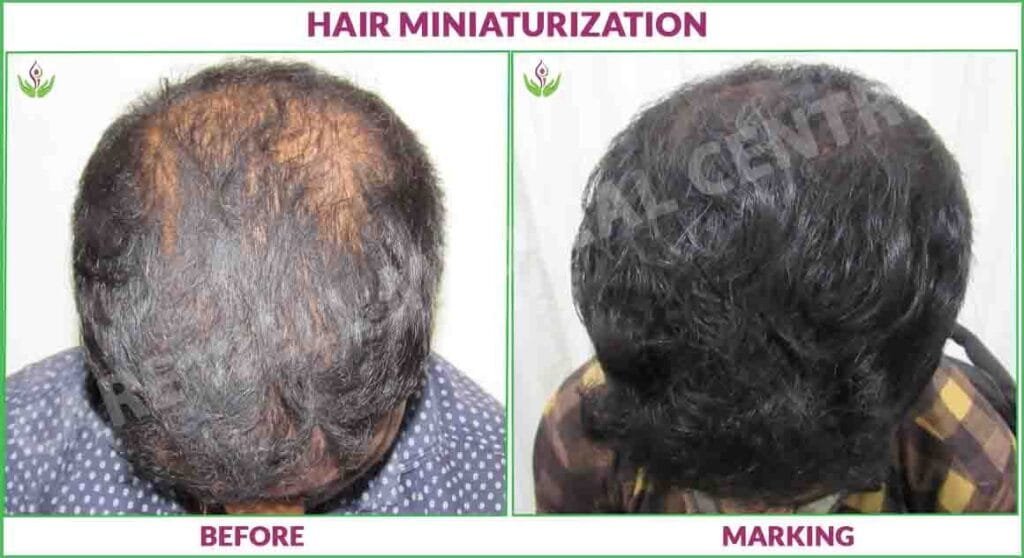What is Hair Miniaturization?
Hair miniaturization is a hormone-driven biological phenomenon in which the hair strands become thinner, weaker, lackluster, brittle, or shorter with each successive progression through the hair growth cycle, eventually leading to pattern baldness.
In a few cases, hair may just stop growing altogether. However, this condition can be effectively treated when diagnosed early in life, aiding the impacted individuals to experience a rejuvenated and self-esteem-filled life all again.
The hair follicle growth cycle comprises three phases:
- Anagen (Growth Phase)
- Catagen (Transitional Phase)
- Telogen (Resting Phase)
How DHT Affects Hair Miniaturization?
In genetically susceptible hair follicles, a special form of testosterone hormone known as dihydrotestosterone (DHT) is another common cause of hair miniaturization. High levels of DHT cause the hair cycle growth phase to become progressively shorter. High levels of DHT can have a detrimental impact on the functionality and health of hair follicles by causing them to shrink progressively; eventually, DHT may even result in the hair follicle disappearing.
In this way, a person’s hairs produced by these follicles become incapable of growing to full size because of this curtailed growth window, and so they are reduced in size (diameter and length) over time until they finally disappear. In genetically inherited hair follicles, a specific type of hair loss called androgenetic alopecia can cause a cessation in the hair cycle growth phase.
The hair miniaturization caused by androgenetic alopecia typically starts as hair recedes from either or both temporal sides of the head, creating the “M” shape for which female and male pattern baldness is widely recognized. Additional miniaturization may take place at the crown (top) of the scalp and on the back crown as well, depending upon the severity of the condition.
Hair generally stops growing as the miniaturization process continues, making it thinner, lifeless, and ultimately leading to complete baldness in the affected area. According to statistics provided by NIH.gov, an estimated 35 million American men as well as several million women are severely affected by androgenetic alopecia.
Miniaturization
In DHT-susceptible miniaturization or pattern hair loss, hair follicles undergo miniaturization, shrinking from terminal to vellus-like hairs. In any single DHT-susceptible follicular unit, the terminal hairs might be in different stages of miniaturization and thus be of distinguished diameters. When there are plentiful terminal hairs in a state of miniaturization, there occurs a detectable thinning of the hair or patterned baldness in the affected areas. As enough hairs in each follicular unit become miniaturized, the process may result in full baldness in that area of the scalp. Usually, scalp hair grows in follicular units made up of 1 to 4 terminal (full-thickness) hairs.
The process would take too long for evident miniaturization to take place secondary to shorter anagen cycles alone, specifically in the aspect of the latent lag period observed in pattern hair loss that happens between the loss of a telogen hair and the appearance of an anagen hair. However, hair miniaturization reversal is clinically possible in individuals with thinning or patterned hair loss responding to finasteride treatment. It is conjectured that the miniaturization visible with pattern hair loss may be the straightforward outcome of decreasing the cell number and, therefore, the size of the dermal papilla.
DHT Resistance
In some parts of the scalp, few or all of the follicular units have the genetic vulnerability to remain secure against the adverse effects of DHT. As an outcome, these areas of the scalp might never become miniaturized, and so hair will remain to exist on these regions of the scalp for an individual’s entire life. This mainly occurs in the sides and back of the scalp, pertinently called the “permanent zone,” while the top and front of the scalp are the primary and most likely to experience baldness and thinning. Specifically, as a result of genetic resistance to DHT in the permanent zone, hair transplant surgery can be the most effective treatment for hair loss.
In the process of hair transplant, follicular units are removed from the permanent parts of the scalp and harvested into balding regions. Due to the occurrence of a phenomenon called “donor dominance,” these transplanted follicular units keep possession of their DHT resistance even when transplanted into a region that was previously occupied by hair that was affected by genetic thinning. The follicular units, once transplanted, will proceed to grow normal, non-miniaturized terminal hairs for the entire life span of the individual. Since hairs in the permanent zone offer donor hairs for application in surgical hair transplantation, this area of the scalp is also known as the donor area.
Miniaturization in the Donor Area
Miniaturization in the donor area is rare but can affect a patient’s eligibility for a hair transplant. If the donor hair becomes miniaturized over time, it defeats the purpose of a transplant, as the transplanted hair will eventually thin and disappear.
- Less Common in Men, More Common in Women: This explains why fewer women qualify for surgical hair transplants compared to men. Only women with a stable donor area are recommended for hair restoration surgery.
- Determining the Right Age for Hair Transplant: Severe hair loss in the late teens or early twenties makes it difficult to predict if the donor area will remain stable. If surgery is performed too early, the donor area may later miniaturize, leading to:
- Loss of transplanted hair
- Visible scars in the donor area
- No long-term cosmetic benefits
- Hair Transplants are Recommended for Patients 25+ Years Old: If donor area miniaturization exceeds 30-40%, a hair transplant is not advised.
- Scalp Biopsy is Crucial: A scalp biopsy is the most reliable diagnostic procedure before determining the best treatment plan. It helps assess the stability of the donor area and whether surgery is a viable option.
Counter-acting the Effects of DHT
Since DHT is the major reason for male pattern baldness, why not find a way to stop hair miniaturization by preventing DHT from causing shrinking? Let’s learn about what exactly happens with the medication “Propecia (finasteride).”. The finasteride obstructs the enzyme 5-alpha reductase Type II from transforming the testosterone hormone into DHT. With lower levels of DHT present in the bloodstream, fewer follicular units are revealed to the miniaturizing impacts of DHT, and thus, they continue to grow thick, healthy terminal hairs.
Rogaine, which is a topical medication for hair loss, also counteracts the adverse impacts of DHT but goes about it in a completely distinguished manner. DHT lowers down the growth phase of the hair cycle, resulting in progressively thinner and smaller hairs. Minoxidil, an active drug in Rogaine, works by elevating the growth phase of the hair cycle. It works well in early hair loss and usually eliminates the need for a surgical procedure. The outcome displays reverse miniaturization, with fewer follicular units that encounter miniaturization.
What are Examples of Miniaturization?
Check here for 3 examples of different intensities of miniaturization: the permanent zone with lesser to no miniaturization, medium miniaturization, and immense miniaturization.
Example 1: The Permanent Zone
In the following candidate, the transplant expert views a close-up of the side of the patient’s scalp where the hair is not affected by DHT. Mostly the cluster of full-thickness hairs (termed terminal hairs), fine villous hairs, or some scattered hairs are normally seen in a donor area.
Example 2: Moderate Miniaturization
In the following condition, most of the hair is miniaturized, even though all of the hair is still present. The hairs, while still remaining on the scalp, are so much thinner in diameter than the original hair that they give the visual look of thinning.
Example 3: Extensive Miniaturization
In this type, there is extensive miniaturization in the center of the scalp and little loss of actual hairs. Although, because of the tremendous thinning of the hair diameter, there is an impression of almost full balding in the area despite the existence of fine hair. What these examples depict is that, specifically in the early stages, the occurrence of balding is seemingly due to the progressive reduction in hair shaft size caused by the miniaturizing upshots of DHT, rather than the actual loss of hair.
Hair Miniaturization Before and After Results


Hair Miniaturization FAQs
KNOW THE ANSWERS TO FREQUENTLY ASKED QUESTIONS RELATED TO Hair Miniaturization HERE
Hair miniaturization is a process where hair strands become progressively thinner, weaker, and shorter due to the shrinking of hair follicles. This condition often leads to hair thinning and pattern baldness if left untreated.
The most common cause of hair miniaturization is dihydrotestosterone (DHT), a hormone that shortens the hair growth cycle and shrinks follicles. Other factors include genetics, poor nutrition, stress, and certain medical conditions.
Signs of hair miniaturization include:
Gradual thinning of hair
Hair strands becoming shorter and weaker
Increased scalp visibility
Receding hairline or thinning at the crown
Yes, if detected early, hair miniaturization can be slowed or reversed with treatments like DHT blockers, PRP therapy, minoxidil, and finasteride. In severe cases, a hair transplant may be necessary.
No, hair miniaturization refers to the gradual thinning and weakening of hair, while hair loss involves the complete shedding of hair. However, miniaturization can eventually lead to permanent hair loss.
Yes, if miniaturization occurs in the donor area, the hair may not be suitable for transplantation, as the transplanted hairs could also thin and disappear over time. A scalp biopsy can help determine donor hair stability.
Hair miniaturization can begin in the late teens or early twenties, especially in those with a family history of androgenetic alopecia. However, it can also occur later in life due to hormonal changes.
To prevent hair miniaturization:
Use DHT blockers like finasteride or natural alternatives
Maintain a healthy diet rich in vitamins and proteins
Avoid excessive heat styling and harsh chemicals
Reduce stress through exercise and relaxation techniques
The best treatments depend on the severity of miniaturization. Options include:
Minoxidil (topical solution to stimulate hair growth)
Finasteride (oral medication to block DHT)
PRP therapy (platelet-rich plasma injections for follicle stimulation)
Low-level laser therapy (LLLT) to promote blood circulation in the scalp
If you notice excessive hair thinning, a receding hairline, or bald spots, consult a dermatologist or hair specialist as soon as possible. Early intervention increases the chances of stopping or reversing hair miniaturization.
